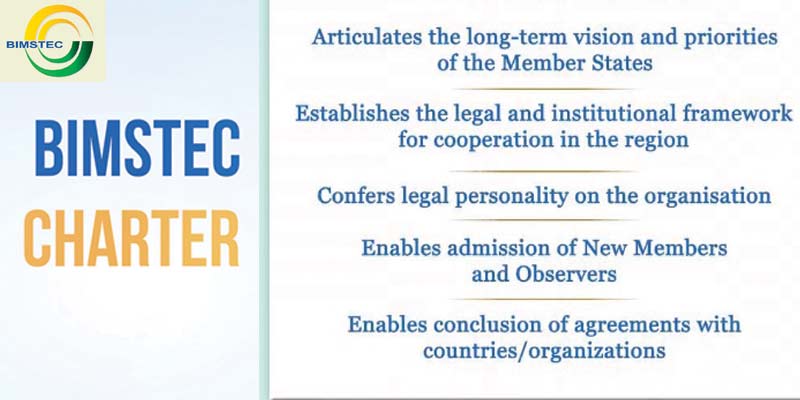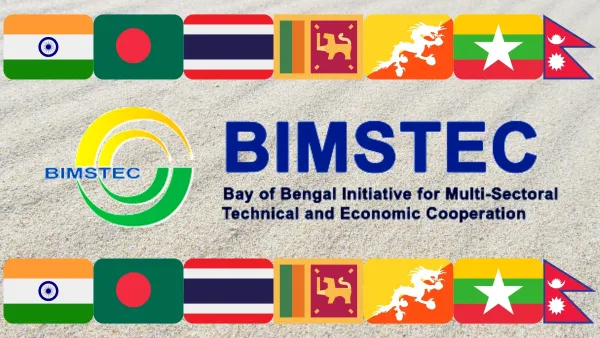Table of contents
The Bay of Bengal Initiative for Multi-Sectoral Technical and Economic Cooperation (BIMSTEC), established in 1997, will now be open to new members and observers after a historic first charter of the grouping came into force on 20 May, 2024.
Acquisition of Legal Personality
BIMSTEC recently acquired a ‘legal personality’ with the coming into force of its first charter on 20 May.
- This milestone was achieved during the 5th BIMSTEC leaders' summit, held virtually under Sri Lanka’s chairmanship on 30 March 2022.
- The adoption of the charter was a significant step in formalizing the organizational structure and operational mechanisms of BIMSTEC, which had struggled to achieve consensus among its seven member states for many years.
The delay?
The final ratification came from Nepal's parliament, which paved the way for the charter to come into effect.
With this formal charter, BIMSTEC can now:
- Invite new members and observers, potentially expanding the grouping.
- Engage in structured diplomatic dialogues with other regional groupings and countries.
BIMSTEC Charter

Implications of Legal Personality
- Formal Structure and Recognition: BIMSTEC’s legal personality means that it is now recognized as a formal entity with the ability to enter into agreements and interactions with other international organizations and countries. This enhances its diplomatic and operational legitimacy on the global stage.
- Institutional Framework: The charter provides a comprehensive legal and institutional framework that supports meaningful cooperation and deeper integration among member countries. This includes clear guidelines on decision-making processes, roles, and responsibilities.
- Operational Efficiency: With a formal structure, BIMSTEC can streamline its activities, making policy implementation and operational tasks more efficient. This structure helps in reducing ambiguities and improving coordination among member states.
- Expanded Membership and Observers: The ability to admit new members and observers can enhance the grouping’s influence and cooperation scope, potentially attracting more countries and organizations interested in regional stability and development.
- Enhanced Cooperation: The charter aims to promote regional cooperation in various key sectors such as security, connectivity, trade, agriculture, environment, science and technology, and people-to-people contact. This holistic approach is designed to foster comprehensive regional development.
Also Read: What is BIMSTEC?
Background and Strategic Significance
Historical Context:
- Formation and Early Years:
- Established: BIMSTEC was formed in 1997.
- Member States: Bangladesh, Bhutan, Sri Lanka, Nepal, Thailand, Myanmar, and India.
- Regional Integration: The region was highly integrated until the early 20th century but lost its cohesion post-independence of the member countries. BIMSTEC aims to revive this historical connectivity and common interests.
- Adoption of the Charter:
- Initial Challenges: For a long time, the organization struggled to form a consensus among its member states regarding a common charter.
- 5th Summit: The charter was adopted during the 5th summit of BIMSTEC leaders on March 30, 2022, held virtually under the chairship of Sri Lanka.
- Ratification: Nepal's parliament ratified the charter last month, paving the way for its enforcement.


Strategic Shifts
- Shift from SAARC to BIMSTEC:
- SAARC's Status: The South Asian Association for Regional Cooperation (SAARC) has been largely inactive since its last summit in Kathmandu in November 2014.
- The next summit, scheduled for Islamabad in 2016, was derailed due to terror attacks in India blamed on Pakistan-based elements.
- India's Focus: Statements from the Indian government indicate a shift in focus from SAARC to BIMSTEC, which aligns better with India's Act East policy.
- SAARC's Status: The South Asian Association for Regional Cooperation (SAARC) has been largely inactive since its last summit in Kathmandu in November 2014.
- SAARC vs. BIMSTEC: BIMSTEC gained prominence against the backdrop of the stalled SAARC process, especially after the 2016 summit in Islamabad was derailed due to India-Pakistan tensions.
- China’s Influence: As China makes significant inroads in the Indian Ocean region through its Belt and Road Initiative, BIMSTEC offers a platform for India and other member states to enhance regional cooperation and counterbalance China's influence.
Challenges and Setbacks
- Regional Geopolitical Tensions: Discord between member countries.
- Internal political issues like Myanmar's military coup, have posed challenges.
- Bangladesh and Myanmar: BIMSTEC has faced challenges due to tensions between Bangladesh and Myanmar, particularly over the displacement of more than a million Rohingya refugees into Bangladesh in 2017.
- Similar issues have arisen with refugees streaming into Thailand following the 2021 coup in Myanmar.
- Operational Delays: BIMSTEC has faced issues with timely policy meetings and operational efficiency due to financial and manpower constraints.
Conclusion
The acquisition of a legal personality through the BIMSTEC Charter marks a significant step in the evolution of the Bay of Bengal Initiative for Multi-Sectoral Technical and Economic Cooperation.
This development not only formalizes BIMSTEC's operational framework but also positions it as a pivotal organization for regional cooperation, reflecting a shared commitment to peace, prosperity, and sustainability in the Bay of Bengal region.
Previous Post